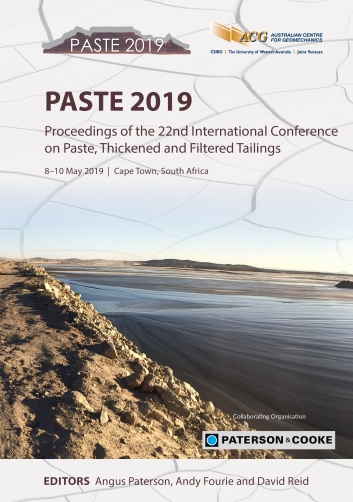Effects of the mineralogical composition and particle size distribution on the rheology of gold and copper tailings

|
Authors: Desriviers, P; Quintero, A; Primeau, P |
DOI https://doi.org/10.36487/ACG_rep/1910_38_Desriviers
Cite As:
Desriviers, P, Quintero, A & Primeau, P 2019, 'Effects of the mineralogical composition and particle size distribution on the rheology of gold and copper tailings', in AJC Paterson, AB Fourie & D Reid (eds), Paste 2019: Proceedings of the 22nd International Conference on Paste, Thickened and Filtered Tailings, Australian Centre for Geomechanics, Perth, pp. 504-514, https://doi.org/10.36487/ACG_rep/1910_38_Desriviers
Abstract:
Globally there is an upward trend by mining operations to opt for tailings dewatering technologies to reduce water consumption, minimise surface disturbance (footprint), increase the stability of tailings deposits and, overall, to operate sustainably. The properties of the mine tailings are largely dictated by the type of ore and the process necessary to liberate the metal values. In other words, it depends on the beneficiation process and the mineralogy of the gangue. Due to the importance of selecting the correct strategy for the management of mine tailings, designing a disposal strategy based solely on the requirements of ore processing may overlook opportunities to maximise the viability of the mining operation, especially when dewatering technologies are being considered. As an example, accepting a coarser grind may reduce overall metal recovery; however, the loss in revenue may be offset by improved dewatering performance and lower capital and operating cost to manage the tailings. Therefore, the design of the ore beneficiation process should consider the requirements for tailings disposal, specifically tailings dewatering and storage facility design, in order to obtain more efficient and sustainable mining operations. This paper will discuss the effects of mineralogical composition and particle size distribution of gold and copper tailings on rheological properties, which provides an indication of what can be achieved in thickener underflows. The present paper is based on laboratory tests performed by Golder Associates on mine projects around the globe.
Keywords: rheology, thickening, mineralogy
References:
ASTM International 2015, D4464 Standard Test Method for Particle Size Distribution of Catalytic Materials by Laser Light Scattering, ASTM International, West Conshohocken.
Burdukova, E, Becker, M, Ndlovu, B, Mokgethi, B & Deglon, D 2008, ‘Relationship between slurry rheology and its mineralogical content’, Centre for Minerals Research, Department of Chemical Engineering, University of Cape Town, Cape Town.
Farrokhpay, S & Ndlovu, B 2013, ‘Effect of phyllosilicate minerals on the rheology, colloidal and flotation behaviour of chalcopyrite mineral’, Chemeca 2013: Challenging Tomorrow, Engineers Australia, Barton.
Jewell, MJ & Fourie, AB 2006, Paste and Thickened Tailings – A Guide, 2nd edn, Australian Centre for Geomechanics, Perth.
Klein, C & Hurlbut, CS 1993, Manual of Mineralogy, Wiley and Sons, New York.
Luckham, PS & Rossi, S 1999, ‘The colloidal and rheological properties of bentonite suspensions’, Journal of Colloid and Interface Science, vol. 82, pp. 43–92.
Ouellet, S & Brunet, F 2010, ‘Design of the paste backfill recipe for the Pinos Altos Mine, Mexico – influence of tailings clay mineral fraction on strength and rheology’, in R Jewell & A Fourie (eds), Proceedings of the 13th International Seminar on Paste and Thickened Tailings, Australian Centre for Geomechanics, Perth, pp. 217–227.
Scales, PJ, Johnson, SB & Kapur, PC 1999, ‘The influence of surface chemistry on the rheology and flow of flocculated particulate suspensions’, Mineral Processing and Extractive Metallurgy Review: An International Journal, pp. 27–41.
Sridharan, A & Jayadeva, MS 1982, ‘Double layer theory and compressibility of clays’, Géotechnique, vol. 32, pp. 133–144.
Tomita, K & Takahashi, H 1985, ‘Curves for the quantification of mica/smectite and chlorite/smectite interstratifications by X-ray powder diffraction’, Clays and Clay Minerals, vol. 33, no. 5, pp. 379–390.
© Copyright 2025, Australian Centre for Geomechanics (ACG), The University of Western Australia. All rights reserved.
View copyright/legal information
Please direct any queries or error reports to repository-acg@uwa.edu.au
View copyright/legal information
Please direct any queries or error reports to repository-acg@uwa.edu.au


